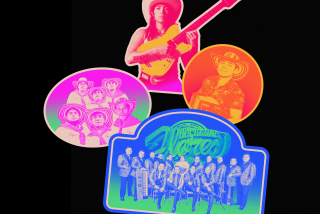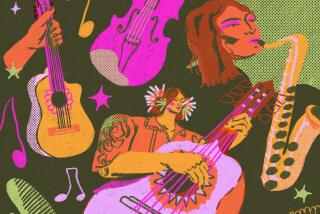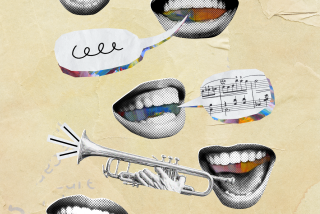Wielding Instrument of Change
Tex-Mex performer Joel Guzman confesses an odd musical secret in the opening minutes of âAccordion Dreams,â a new documentary about the instrument heâs played all his life.
âBefore, [people would] say, âOnly geeks play the accordion,ââ he explains. âSo you always practiced in a room and by yourself. Donât let anybody know.â
Judging by the way Guzman and other so-called ârebel accordionistsâ sling their squeezeboxes around on stage--and by the way their female fans scream as if they were rock stars--the lowly accordion has come out of hiding with a vengeance.
The one-hour documentary--which airs tonight on KCET in Los Angeles--chronicles the journey of the button accordion from central Germany to central Texas, where it became the key instrument in the conjunto music of Mexican Americans.
The popularity of the instrument spread throughout the U.S. with waves of migrant workers and gained a new international respect through performers such as Flaco Jimenez and Los Lobos.
In fact, the film informs us, the accordion might well be extinct in popular American music today had it not been for Mexican Americans who infused the awkward instrument with swing and pumped new life into its pleated bellows.
âThis music is not embarrassing anymore,â said Austin-based filmmaker Hector Galan, who wrote and directed the documentary. âItâs our music. It belongs to the Mexican American community. But itâs truly an American genre.â
Galan, 47, started his career as a camera operator in his hometown of San Angelo, Texas, and in the early â80s was a staff producer for âFrontline,â the PBS documentary series produced by WGBH-TV in Boston.
Galanâs previous PBS credits include âChicano! History of the Mexican American Civil Rights Movement,â a four-part series that aired in 1996. Heâs currently working on a three-part series for PBS on Latino art and culture in America.
âItâs been a long struggle to convince the networks of the importance of Latino culture,â says Galan, whoâs had his own production company since 1984. âI can finally bring stories [to the public] that were not being told. That makes me happy.â
âAccordion Dreams,â narrated by singer-songwriter Tish Hinojosa, is the second part of Galanâs planned trilogy on Tex-Mex music, starting with 1995âs âSongs of the Homeland.â
The final segment will focus on the big, brassy Texas orquestas, such as Little Joe y La Familia and Sunny and the Sunliners.
During his research on the roots of the accordion, Galan traveled twice to Germany, where he was surprised to find few signs of the instrument.
âThey lost it,â says Galan. âThey do not embrace this music the way we do as Mexican Americans. So weâre the ones who are maintaining the accordion.â
In the documentary, we meet the elderly descendants of German settlers who came to Texas in the late 1800s with their accordions and lively polkas.
In the town of New Braunfels, people of German stock were once the majority, but their numbers have dwindled since World War II, while the Mexican American population boomed.
âEvery other teenager in town took accordion lessons,â recalls Barron Schlameus, a local historian with the New Braunfels Conservation Society, which operates Conservation Plaza, a replica of a German village. âIt was the social thing to do. Today, thereâs not an accordion teacher to be found.â
As a boy, Tex-Mex accordion ace Jimenez would come to New Braunfels with his father, Santiago Jimenez, to hear the German polka bands.
The elder Jimenez and other Mexican American musicians adopted the button accordion and developed a unique style of playing, more vigorous and exciting than the European counterpart.
The Mexicans preferred the diatonic type of accordion, with three rows of buttons for the melody. It was cheaper and more portable than the more familiar chromatic accordion, which has piano keys instead of buttons.
The Mexican musicians, however, use only the right hand to play the instrument. The left hand, which would normally play bass notes, is free to squeeze the box with gusto, adding that extra oomph that distinguishes their style.
The film shows archival footage and photographs of pioneers of conjunto music, a cousin of norteno that also uses accordion. We meet Narciso Martinez, known as the father of the genre; Eva Ybarra, a self-taught musician who bucked biases against women playing what was considered low-class barroom music; and Valerio Longoria, among the first to put straps on the instrument and play standing up.
It closes with an exiting look at the new generation of players, young men and women who are enthralled by music once considered hokey and old-fashioned.
The rising stars in Texas today include 15-year-old Victoria Galvan of Corpus Christi, âwhose accordion weighs as much as she does,â says her manager and mentor, Shirley Villareal of Hacienda Records.
The young male players have no trouble whipping the instrument over their heads, slinging it below their gyrating waists and twirling around with the strapped device like dervishes. They look no more geeky than rock guitarists.
âI can play guitar,â says rebel accordionist Albert Zamora, sporting a Nike cap and rings on each ear. âI can play bass. I can play drums. You name it, I can play it. But I choose to play the accordion. And if that makes me a geek, somebody get me some glasses!â
*
âAccordion Dreamsâ airs tonight at 8 on KCET.
More to Read
The complete guide to home viewing
Get Screen Gab for everything about the TV shows and streaming movies everyoneâs talking about.
You may occasionally receive promotional content from the Los Angeles Times.






